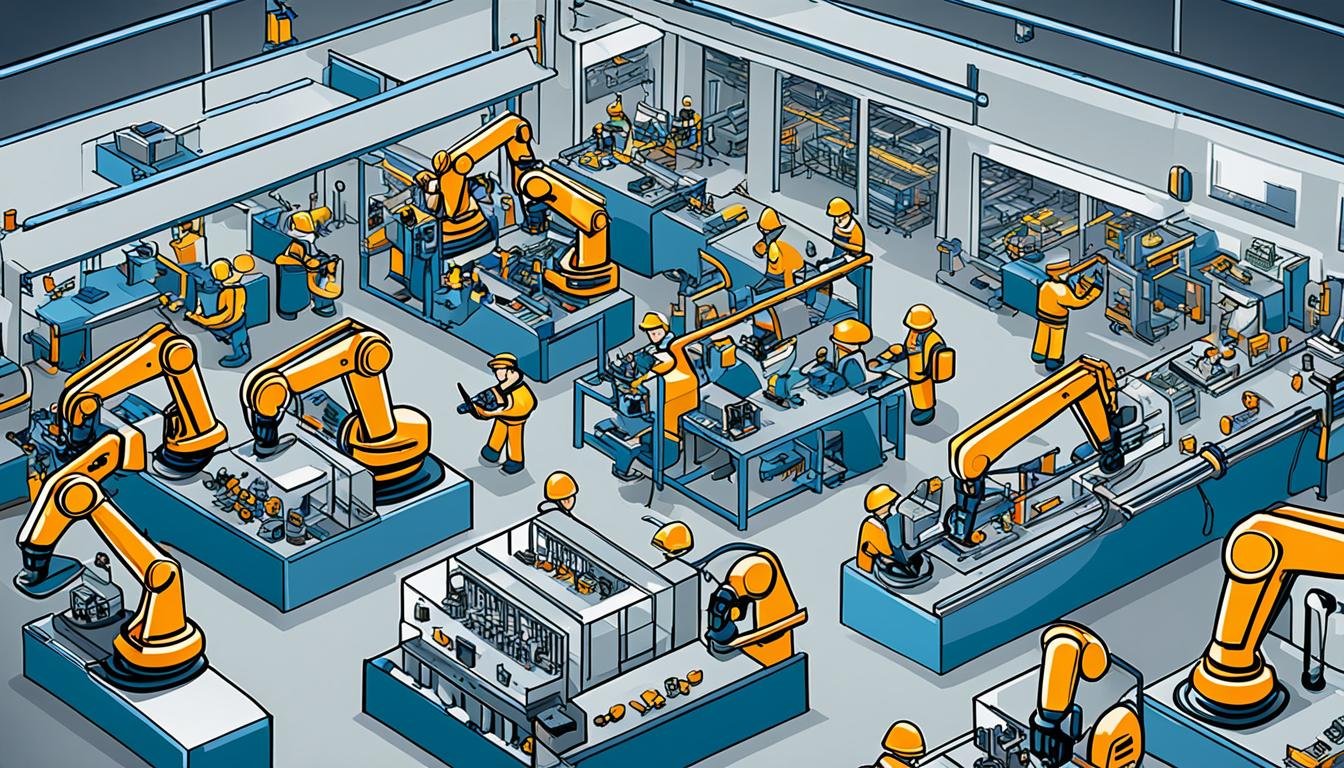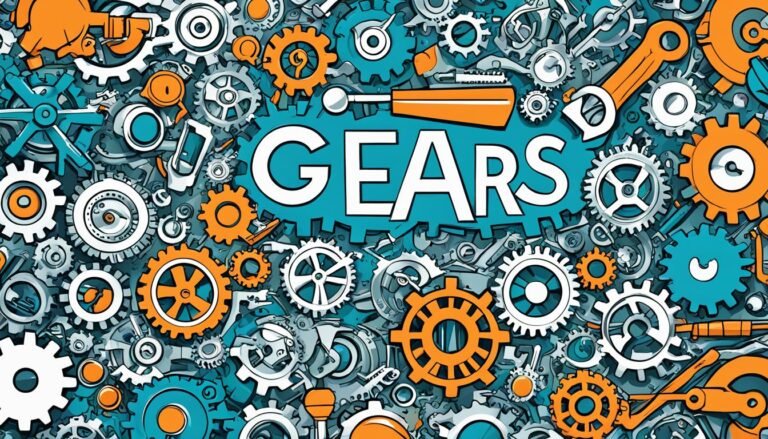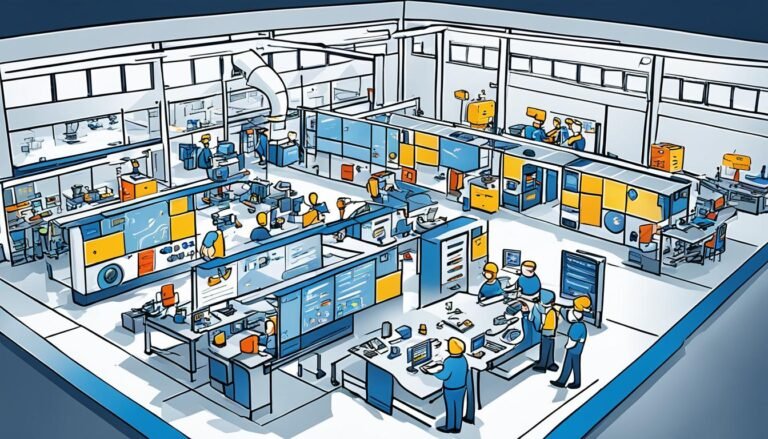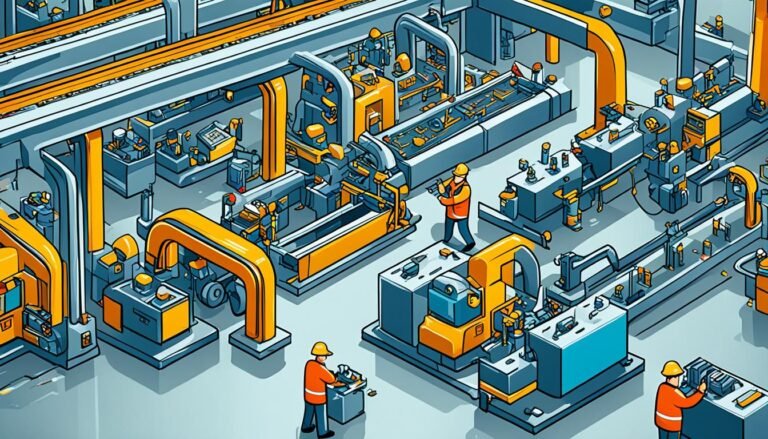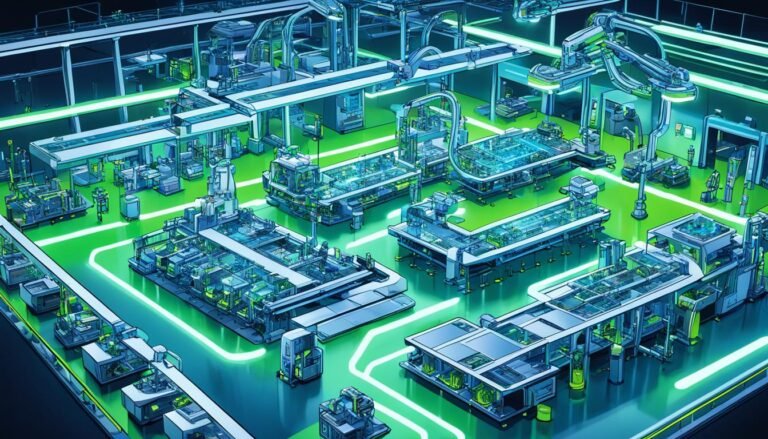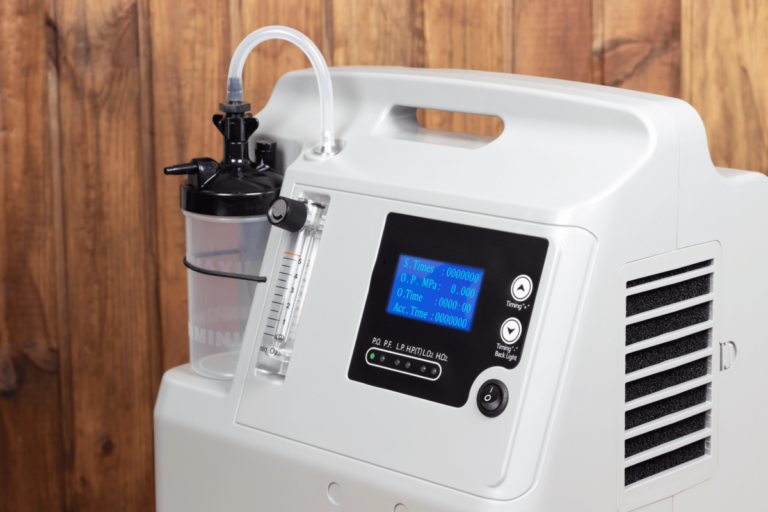Kaizen: Continuous Improvement in Manufacturing
Did you know Toyota cut its manufacturing costs by more than a third over five years with Kaizen? This shows how Kaizen leads to operational excellence through continuous improvement in manufacturing. Lockheed Martin, a global maker of military aircraft and defense systems, also saw big benefits. They cut costs by over a third and delivery times nearly in half.
Kaizen is all about making things better constantly. It gets everyone involved in making processes better and improving things. It works well with lean manufacturing techniques, helping companies make optimized processes for long-term success. This approach focuses on small improvements that add up to big gains in efficiency and productivity.
Key Takeaways
- Toyota reduced manufacturing costs by over 33% in five years using Kaizen
- Lockheed Martin cut manufacturing costs by more than a third and delivery time by almost half
- Kaizen involves incremental improvements that lead to significant overall gains
- Kaizen incorporates employee engagement from all levels to optimize processes
- Consistent application of Kaizen fosters a culture of continuous improvement
Understanding the Kaizen Philosophy
Kaizen means “good change” and is key to making things better, starting in Japan after World War II. It’s now a big part of making things better in many areas like making things, healthcare, and finance.
The Origin and Meaning of Kaizen
Kaizen started in the 1940s and got famous thanks to Masaaki Imai’s book in 1986. It’s all about making small changes often, not big ones. Companies like Toyota use it a lot, thanks to its focus on making things better step by step.
Kaizen Principles and Mindset
Kaizen is about knowing what customers want, making things flow smoothly, and letting workers help make decisions. It uses tools like the 5S process and the PDCA cycle for better improvements. It also values being open and responsible to boost innovation and ownership among workers.
Kaizen as Action Plan and Philosophy
Kaizen is both a plan for making specific areas better and a way of thinking about ongoing improvement. It’s all about teamwork, checking on things often, and changing when needed. For example, Toyota uses “kaizen blitz” for quick fixes. This way, making things better becomes part of everyday work, building a strong culture of excellence.
| Kaizen Element | Description |
|---|---|
| Know Your Customer | Understand and prioritize customer needs. |
| Let It Flow | Facilitate smooth and efficient workflows. |
| Go to Gemba | Observe and analyze work processes directly at the source. |
| Empower People | Encourage employee participation and innovation. |
| Be Transparent | Maintain clear and open communication within the organization. |
Implementing Kaizen in Lean Manufacturing
Starting with Kaizen in lean manufacturing means having a clear plan. It begins with events where teams work together on specific goals. These events help employees at all levels improve together, creating a culture of ongoing betterment.
At the heart of these events is learning about the best ways to do things, or standardized work. Then, teams look for ways to get even better.
Organizing Kaizen Events
Kaizen events are key in lean production. They start with a deep look at how things are now. This lets teams come up with ideas for making things better.
After picking the best ideas, teams put the changes into action. They check how things are going, make tweaks, and keep improving. This cycle keeps the focus on making things better and keeping those improvements going.
The Role of Standardized Work in Kaizen
Standardized work is a big part of lean production. It means documenting how things are done now. This baseline helps teams see where they can get better.
By sticking to these standards, teams can spot and fix inefficiencies. Tools like machine monitoring software give real-time data. This data helps teams make smart changes with Kaizen.
Gemba Kaizen and the Gemba Walk
Gemba Kaizen takes Kaizen to where the work is done. The Gemba Walk is a key part of this. Managers go right to the shop floor to see how things work.
This hands-on approach gives managers real insights from the workers. It supports a style of management that listens and acts. Gemba Kaizen lets employees share their ideas, driving ongoing improvement.
Key Processes and Tools for Kaizen
Kaizen is all about making things better and keeping quality high. It uses many processes and tools to do this. These methods help keep making things better all the time, making a culture of excellence.
Understanding PDCA (Plan, Do, Check, Act)
The PDCA cycle is key to Kaizen. It helps us improve by planning, trying things out, checking how they go, and making changes. This way, we can make changes step by step and keep getting better.
5S Framework for Workplace Efficiency
The 5S Framework is a big help in making work places run smoothly. It has five steps: Sort and clear, Shine, Set in order, Standardize, and Sustain. These steps make sure the workplace is organized, clean, and efficient, cutting down on waste.
Using Value Stream Mapping
Value stream mapping is a powerful tool. It shows how we make products and services. By looking at it, we can find where things slow down and how to make them better. This leads to leaner operations and better workflow.
Importance of Quality Control and Waste Elimination
Quality control and getting rid of waste are key for success in making things. Taiichi Ohno talked about seven wastes: Transportation, Inventory, Motion, Waiting, Overproduction, Processing, and Correction. By getting rid of these, companies can save money, make better products, and give customers more value.
Kaizen: Continuous Improvement in Manufacturing
Kaizen is all about making small changes that add up to big results. It turns making things better into a way of life in manufacturing. This approach leads to big changes over time.
Incremental Changes for Big Results
Kaizen says small changes can lead to big outcomes. Fixing small problems now can lead to big improvements later. For example, Lockheed Martin and Ford Motor Company used Kaizen to cut costs and speed up production.
These companies show how making small changes can lead to big leaps in innovation. The Toyota Production System (TPS) is a great example. It shows how making small improvements every day can keep a company successful over time.
Data-Driven Decisions
Using data helps make sure Kaizen changes work well. It uses data to check if changes meet goals. This way, companies can make smart choices to improve their processes.
The PDCA (Plan-Do-Check-Act) cycle helps guide these improvements. It makes sure ideas go from start to finish. By using data, companies can keep making their processes better and more efficient.
Employee Engagement and Innovation
Getting everyone involved in Kaizen is key to its success. When employees feel part of the improvement process, they come up with more ideas. This leads to more innovation in manufacturing.
Listening to employee ideas can lead to great solutions. Pixar Animation Studios is a great example. They use employee ideas to reduce risks and boost creativity through constant improvement.
Leaders play a big role in this by promoting open communication and recognizing small wins. Together, these efforts show the power of Kaizen. They make it clear how it leads to lasting success in manufacturing.
Conclusion
Kaizen is all about making things better bit by bit. It fits perfectly with lean manufacturing’s goals. By working together, asking questions, and innovating, Kaizen helps manufacturers get better at what they do.
The Kaizen method uses the PDCA cycle and the 5S framework for ongoing improvement. Gemba walks and value stream mapping help spot areas to get better. This approach links employees and management closely, making sure everyone works together for better results.
Companies that follow Kaizen build a strong base for lasting success. It’s not just about doing things faster or cheaper. It’s about always getting better and growing. This leads to more work done, better quality products, and less waste. It helps companies stay ahead in a fast-changing market.
Source Links
- What is Kaizen (Continuous Improvement) in Manufacturing?
- Kaizen: Culture of Continuous Improvement
- Kaizen: Understanding the Japanese Business Philosophy
- The Kaizen philosophy: A guide to continuous improvement
- Kaizen: A Philosophy of Continuous Improvement
- Implementing Kaizen in Manufacturing | Kaizen for Manufacturers
- How Kaizen and Lean Manufacturing Work Together
- 14 top continuous improvement tools for modern manufacturing – CCI
- Lean Six Sigma 101: Continuous Improvement | KAIZEN™
- Top 6 Kaizen Tools for Maximum Productivity – Teamhood
- What is Kaizen (Continuous Improvement)?
- How to build a continuous improvement plan using kaizen – CCI
- What is Kaizen in Manufacturing: Understanding Continuous Improvement
- Kaizen: Continuous Improvement with the Kaizen Method
- Concept Of Kaizen In Manufacturing | Mechanical Power Inc.

